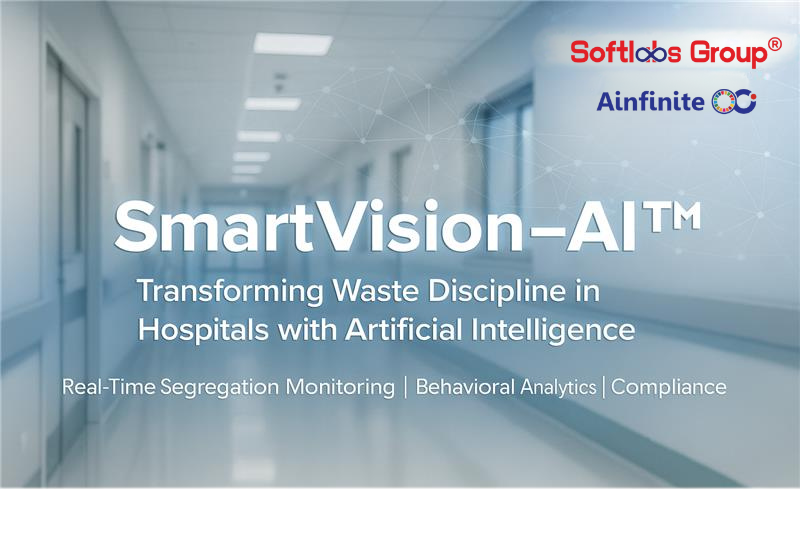
The Opportunity for AI-Driven Hygiene Transformation
Improper waste segregation represents a critical operational and safety failure in modern healthcare. India, for example, generates approximately 700 tonnes of biomedical waste every day. A significant portion of this risk originates at the first point of disposal. The simple act of placing an incorrect item into a bin creates a chain reaction of contamination, regulatory exposure, and environmental harm. Traditional methods of manual supervision and periodic audits are reactive and fail to address the problem at its source. This gap in enforcement presents a clear opportunity for technological intervention. An AI hospital waste management system offers a paradigm shift, moving facilities from inconsistent, after-the-fact correction to proactive, automated enforcement.
Using advanced computer vision for waste sorting, such a system monitors every disposal event in real-time. It provides immediate feedback and creates an unbroken chain of accountability. This technology transforms a manual challenge into a data-driven process. The right AI hospital waste management system establishes a new benchmark for hygiene and operational excellence.
1. The Challenge: The High Cost of Improper Biomedical Waste Segregation
Context: A Growing Crisis in Healthcare Waste Management
The rapid expansion of the healthcare sector has created a proportional growth in biomedical waste. This surge presents a significant public health and environmental challenge. In India alone, there are over 393,000 healthcare facilities (HCFs), many of which are non-bedded clinics and labs that contribute to the waste stream.
A core issue in hospital medical waste management is the frequent mixing of hazardous biomedical materials with general municipal waste. This practice exposes the public, sanitation workers, and waste handlers to unnecessary risks.
The problem is not a lack of regulation. India’s Bio-Medical Waste Management Rules, 2016, provide a clear framework for proper handling and segregation. However, on-the-ground implementation often falls short. The challenge lies in effective, scalable enforcement.
Even in the US, it is not the lack of regulation, but its complexity. Unlike a single federal mandate, medical waste is primarily regulated at the state level, creating a patchwork of different rules. While federal agencies like OSHA provide crucial guidelines for worker safety, the specific definitions and disposal requirements vary significantly from state to state
An AI hospital waste management system directly addresses this enforcement gap. It provides an automated, unbiased, and continuous monitoring solution that manual processes cannot replicate. This is a critical tool for any facility serious about biomedical waste management in hospital settings.
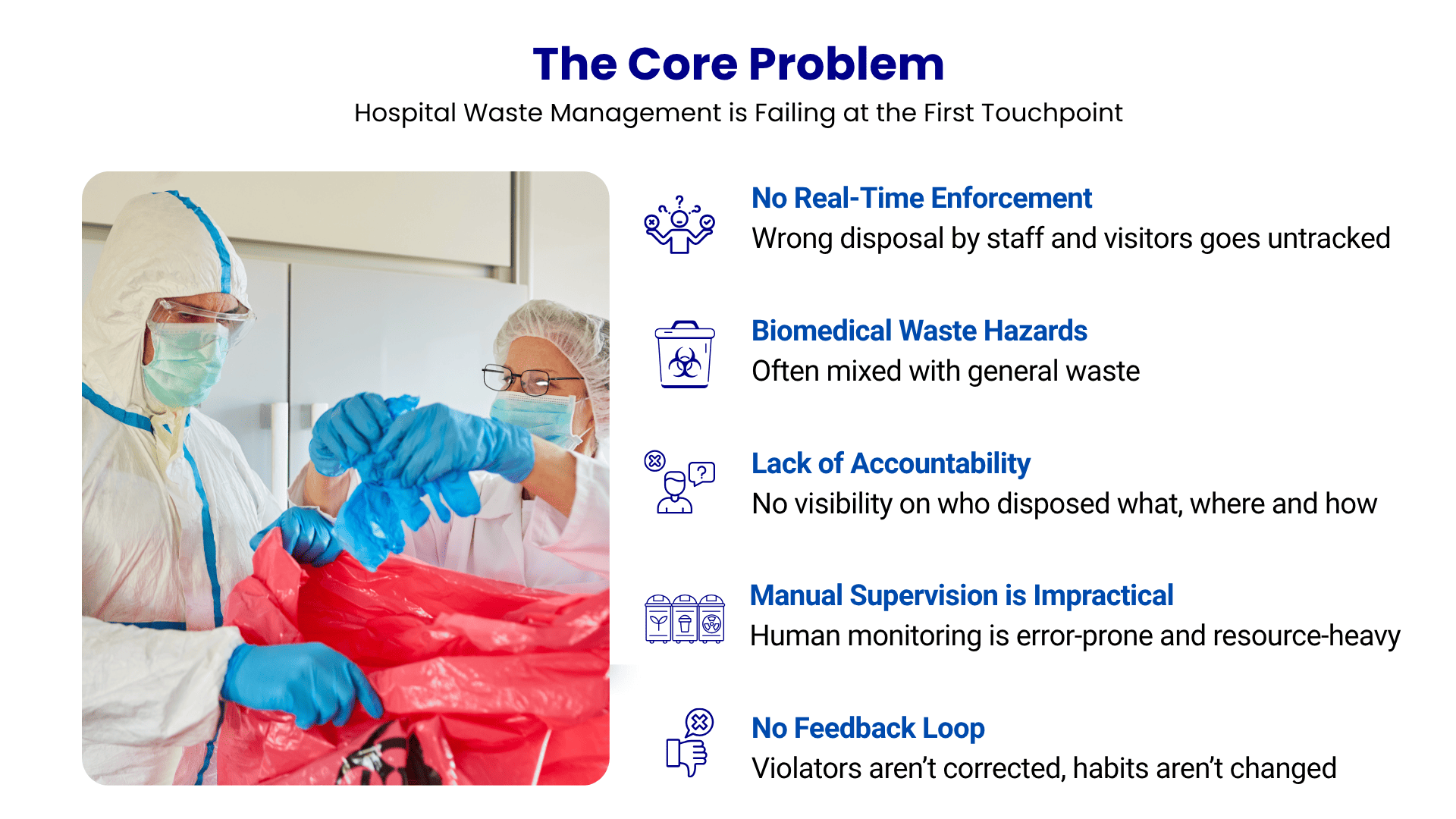
Key Pain Points Addressed by AI
Improper waste segregation in hospital environments creates tangible, high-stakes problems for administrators. An intelligent system can directly mitigate these key pain points:
- Severe Health & Safety Risks: Contaminated waste contains harmful microorganisms that can infect patients, staff, and the community. According to the World Health Organization, sharps-inflicted injuries from improperly disposed needles pose a significant risk of transmitting diseases like HIV and Hepatitis B. These risks extend beyond the hospital walls to sanitation workers and recyclers who may come into contact with hazardous materials.
- Environmental Contamination: When hazardous materials enter the general waste stream, they can contaminate soil and groundwater. Inadequate incineration of this mixed waste can also release toxic pollutants into the air, harming both the environment and public health.
- Regulatory Penalties & Reputational Damage: Non-compliance with regulations like the Bio-Medical Waste Management Rules, 2016, is not a hypothetical risk. In 2021, Indian authorities issued over 15,000 show-cause notices to non-compliant facilities. Such penalties result in financial losses and can severely damage a hospital’s reputation for safety and governance.
- Operational Inefficiency and High Costs: Managing mixed waste is expensive. It requires more labor and higher disposal fees, as larger volumes of waste must be treated as hazardous. An effective AI hospital waste management system can help control these escalating operational costs.
Limitations of Traditional Approaches
Current methods for ensuring proper waste disposal are fundamentally flawed because they fail to intervene at the critical moment of decision.
First, manual audits are largely ineffective. Waste management committees and spot-checks are infrequent and inconsistent. They are reactive, identifying problems long after they have occurred and the associated risks have been present for hours or days. They provide a limited snapshot, not continuous oversight.
Next, these traditional methods lack a mechanism for real-time feedback. By the time an audit discovers a violation, the opportunity for immediate correction is lost. This absence of a direct feedback loop makes it difficult to change behavior effectively.
Furthermore, manual systems create accountability gaps. It is nearly impossible to trace a specific act of improper disposal back to an individual. This makes targeted retraining or disciplinary action difficult, allowing poor habits to persist.
Finally, alternative technologies like RFID have significant limitations for this specific problem. RFID tags can track the movement of a waste container, but they cannot see what is placed inside it. They do not prevent a syringe from being dropped into a general waste bin, which is the core failure point. The fundamental flaw of all these approaches is their inability to monitor the action of disposal itself. An AI hospital waste management system is designed specifically to overcome this limitation.
2. AI vs. Traditional & Alternative Methods: A Clear Comparison
For hospital administrators evaluating how to improve waste management, understanding the distinct advantages of an AI-driven approach is crucial. A direct comparison reveals the significant gaps left by older methods.
| Feature | AI Hospital Waste Management System | Manual Audits & Supervision | RFID-Based Tracking |
| Enforcement | Proactive & Real-Time. Flags violations instantly, enabling on-the-spot correction. | Reactive. Identifies issues hours or days later, long after the risk has been created. | None. Cannot see inside the bin; only tracks the container’s location. |
| Accuracy | Extremely High (>95%). Every disposal event is analyzed by the AI model. | Low & Inconsistent. Prone to human error, infrequent, and provides only a small sample of data. | Not Applicable. Does not verify the accuracy of the waste being disposed. |
| Accountability | 100% Traceable. Creates an immutable video/image record of every violation. | Minimal. Nearly impossible to trace a specific violation back to an individual. | Container-Level Only. Tracks the bin, not the person who used it or what they put in it. |
| Data Analytics | Comprehensive. Provides a live dashboard with compliance scores, trend analysis, and peak violation times. | Manual & Limited. Data is collected manually and is often incomplete or outdated. | Limited. Provides location data for containers but no insights into disposal behavior. |
| Labor Cost | Reduces Manpower. Automates the monitoring process, freeing up staff for patient care. | Labor-Intensive. Requires dedicated staff time for supervision and conducting audits. | Moderate. Requires staff to manage tags and readers, but less than manual audits. |
3. Meeting Regulatory Mandates: How AI Ensures Compliance
A) Navigating the Indian Regulatory Landscape
An AI hospital waste management system is more than an operational tool; it is a powerful compliance engine. It directly addresses key mandates within India’s Bio-Medical Waste Management Rules, 2016, transforming regulatory obligations from a manual burden into an automated, auditable process.
- Segregation at Source (Schedule I): The rules explicitly require waste to be segregated into color-coded bags and containers at the point of generation. The AI system enforces this rule for every single disposal action. By instantly verifying if an item matches the correct bin, it ensures compliance in real-time, preventing the cross-contamination that manual checks often miss.
- Training and Accountability (Rule 4g): The regulations mandate that all healthcare workers receive training on proper waste handling. An AI hospital waste management system serves as a continuous training and reinforcement tool. The immediate feedback from an incorrect disposal (such as a voice alert) corrects behavior instantly. Furthermore, the system’s ability to log violations with video evidence creates a clear accountability trail. This allows management to identify individuals or departments that require targeted retraining.
- Record-Keeping and Reporting (Rule 4n & Annual Reports): Facilities are required to maintain records and submit annual reports to regulatory bodies. The healthcare waste analytics dashboard automates this entire process. It generates precise, data-backed reports on compliance rates, violation incidents, and waste volumes, providing irrefutable proof of due diligence for audits and simplifying the annual reporting process.
B) Navigating the US Regulatory Landscape
- State-Level Primary Authority: After the federal Medical Waste Tracking Act expired in 1991, primary authority for regulating medical waste was delegated to individual states. This has resulted in a “patchwork of legal structures” where every state has different rules for waste segregation, storage, transport, and disposal. A configurable AI system can be tailored to meet the specific color-coding and categorization rules of any state.
- OSHA’s Role in Worker Safety: The federal Occupational Safety and Health Administration (OSHA) plays a critical role through its Bloodborne Pathogens Standard. This standard mandates protections for healthcare workers from sharps injuries and exposure to infectious materials. An AI system directly supports OSHA compliance by ensuring sharps and other regulated wastes are placed in the correct, puncture-proof containers at the point of generation.
- EPA’s Influence: While the Environmental Protection Agency (EPA) no longer regulates medical waste directly, it sets stringent emission standards for medical waste incinerators and regulates any chemical treatment technologies under the Federal Insecticide, Fungicide, and Rodenticide Act (FIFRA). By ensuring proper segregation, an AI system helps guarantee that only appropriate materials are sent for incineration, reducing harmful emissions.
4. The Business Case: Understanding the ROI of an AI Waste Management System
Beyond safety and compliance, implementing an AI hospital waste management system delivers a compelling and measurable return on investment (ROI). For administrators, the financial benefits are clear and direct.
Case in Point: The Impact of Real-World AI Deployment
Real-world applications of AI in hospital waste management demonstrate its transformative potential. For example, a large healthcare network that implemented AI to automate waste segregation saw a 40% reduction in non-compliance incidents and a 20% decrease in overall waste management costs. These results highlight the significant, tangible benefits of moving to an intelligent, automated system
- Direct Cost Reduction: The cost of disposing of biomedical waste is significantly higher than for general waste. When hazardous items are improperly mixed with general waste, the entire volume must often be treated as hazardous, dramatically increasing disposal fees. By ensuring over 95% segregation accuracy, the AI system minimizes this cross-contamination, leading to substantial savings on waste management contracts.
- Risk Mitigation and Avoidance of Penalties: Non-compliance with environmental laws carries severe financial penalties. Fines for improper waste disposal can range from ₹50,000 to over ₹1 lakh per incident, and in some cases, can lead to imprisonment. The AI system acts as an insurance policy against these penalties by creating a robust, automated compliance framework.
- Enhanced Operational Efficiency: Manual supervision and waste audits are resource-intensive, consuming valuable staff hours that could be dedicated to patient care. An AI hospital waste management system provides 24/7 monitoring without additional manpower. This reallocation of human resources toward core healthcare functions represents a significant operational efficiency gain and a soft ROI that improves the quality of care.
5. The AI Solution Concept: SmartVision-AI™ Waste Discipline Platform
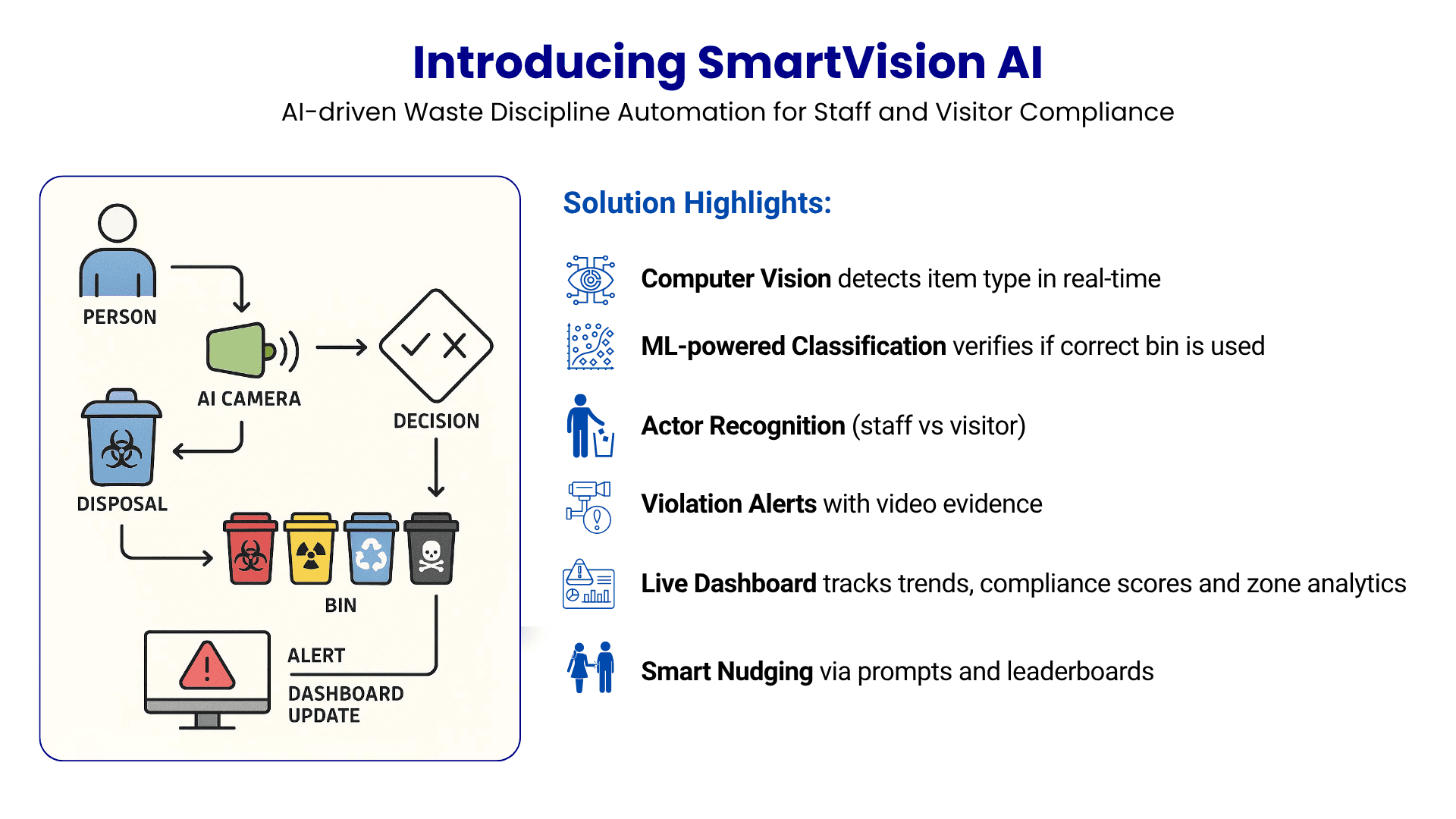
To address these challenges, we envision an AI hospital waste management system that functions as a comprehensive behavior transformation engine. This system, SmartVision-AI™, moves beyond simple monitoring. It establishes a data-driven ecosystem for safety, compliance, and operational excellence.
This is not just a tool; it is a platform for creating a culture of discipline. The core idea behind this AI powered medical waste management solution is to automate enforcement at the source.
Vision & Objectives for an AI-Powered System
The ultimate vision is to create a closed-loop system that makes correct waste disposal the easiest and most reinforced path for all staff and visitors.
- Achieve over 95% accuracy in waste segregation in hospital bins at the point of disposal.
- Provide 100% real-time waste disposal monitoring of all designated bin zones without requiring additional manpower.
- Establish a direct, immediate feedback loop to correct non-compliant behavior and drive measurable improvement in discipline.
- Completely eliminate the mixing of biomedical and general waste in monitored zones, drastically reducing contamination risks.
- Generate irrefutable, data-backed reports for internal reviews and regulatory audits, ensuring seamless automated biomedical waste compliance.
- Create a powerful healthcare waste analytics dashboard that provides actionable insights for continuous process improvement.
Explore Our Custom AI Services !
6. How It Works: The Technology Explained
An advanced AI hospital waste management system operates through a seamless, multi-stage process. This entire workflow, from a person approaching a bin to data appearing on a dashboard, completes in under two seconds.
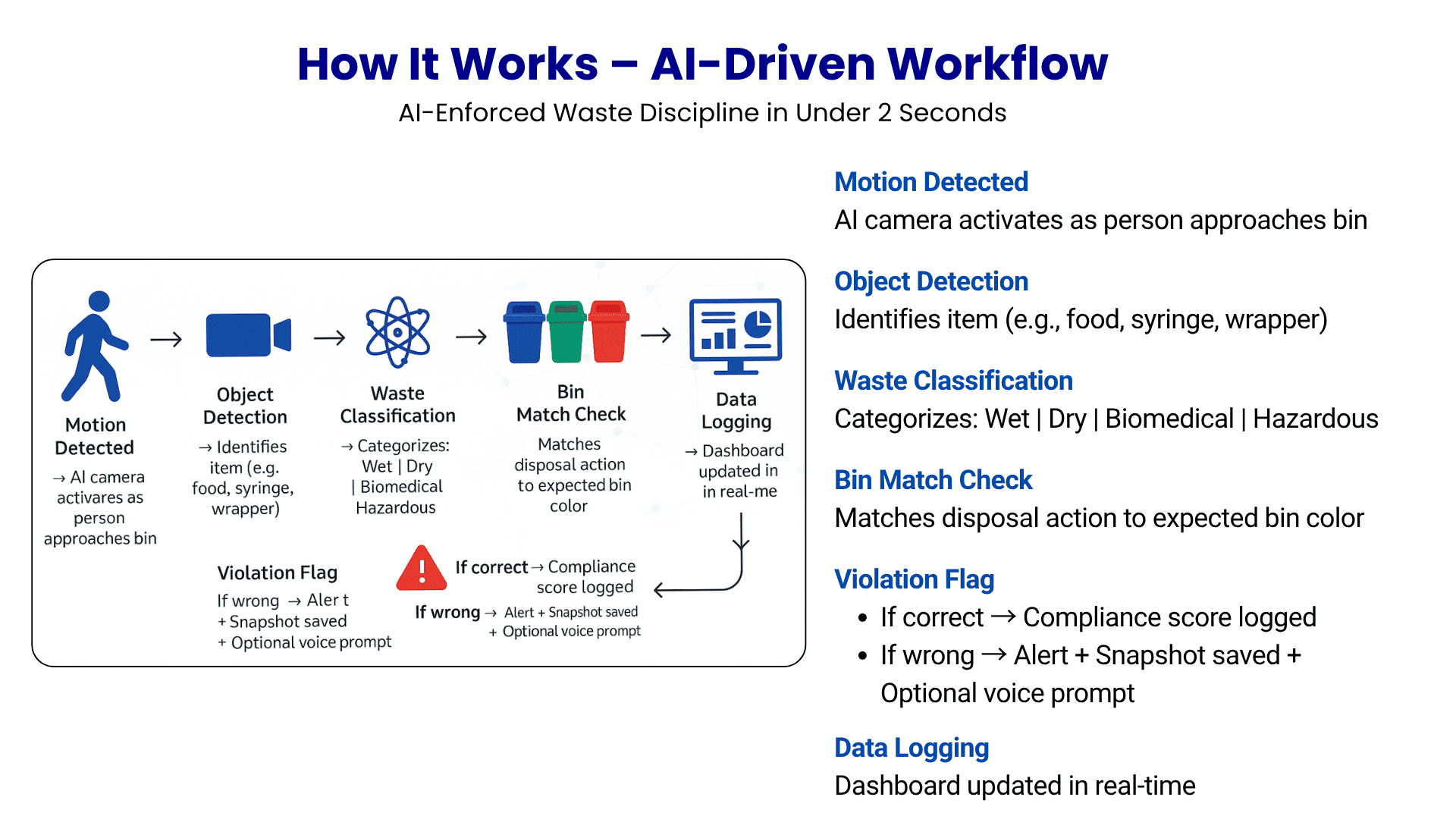
Data Acquisition: The System’s Eyes
The process begins with standard, high-definition IP CCTV cameras. These cameras are strategically positioned to maintain a clear, unobstructed view of the waste disposal bins. They act as the digital eyes of the AI hospital waste management system, capturing a continuous video stream of the area and providing the raw visual data needed for analysis.
The AI Processing Pipeline: From Action to Insight in Under Two Seconds
The core intelligence of the system resides in its processing pipeline. It transforms raw video into actionable insights through a logical, step-by-step sequence.
- Motion Detection. First, the system uses simple algorithms to detect a person approaching a waste bin. This action serves as a trigger. It activates the more powerful AI models only when needed, ensuring the efficient use of computing resources.
- Real-Time Object Identification. Next, as the individual discards an item, the system captures the key video frames. These frames are immediately fed into a powerful computer vision model. Specifically, a state-of-the-art YOLOv8 object detection algorithm analyzes the trash can garbage images. It instantly identifies the object being thrown away, such as a “syringe,” “food wrapper,” or “glass vial.” Research demonstrates that YOLOv8 is exceptionally effective for waste detection, achieving up to 93% segregation accuracy (SA) in real-world tests and significantly outperforming previous AI methods.
- Intelligent Categorization. Once YOLOv8 identifies the object, the system passes the information to a secondary machine learning classifier. This model’s purpose is to assign the identified item to a predefined waste category. These categories align with hospital SOPs and the Bio-Medical Waste Management Rules, 2016, such as “Biomedical,” “Hazardous,” “Wet,” or “Dry”.
- Bin-Match Verification & Action. The system then performs the final and most critical logic check. It verifies if the item’s category matches the designated category for that specific bin. For example, is a “Biomedical” syringe going into the correct red-colored bin?
- If Correct: The system logs the event as compliant. This action contributes positively to the department’s overall compliance score.
- If Incorrect: The system flags a violation instantly. It saves a snapshot and a short video clip as immutable evidence. It logs the violation details and can trigger an optional, pre-recorded voice prompt for immediate, on-the-spot correction (e.g., “Please dispose of medical sharps in the white container”). This entire sequence makes the AI hospital waste management system a powerful tool for ai in clinical waste management.
Output & Interaction: The Healthcare Waste Analytics Dashboard
All data from every disposal action, both compliant and non-compliant, streams in real-time to a central dashboard. This cloud-based interface serves as the command center for the AI hospital waste management system.
It provides authorized managers with live camera feeds and detailed violation logs, complete with video evidence. The dashboard also displays department-specific compliance scores, analytics on peak violation times, and the ability to tag repeat offenders. All reports are easily exportable for audits and administrative review.
7. Key Enabling Technologies: The Core Components of an AI Hospital Waste Management System

The effectiveness of an AI hospital waste management system depends on a sophisticated stack of integrated technologies. Each component plays a distinct and critical role.
- Computer Vision (A field of AI that trains computers to interpret and understand the visual world, allowing machines to “see,” identify, and process images much like humans do ). This is the foundational technology that enables the system to analyze video feeds and recognize disposal activities.
- YOLOv8 (You Only Look Once v8) (A state-of-the-art, real-time object detection algorithm renowned for its exceptional speed and accuracy ). The system uses YOLOv8 to instantly locate and identify the specific items being discarded into bins.
- Machine Learning (ML) Classifier (An algorithm trained to automatically sort data into predefined categories based on learned patterns ). After YOLOv8 identifies an object, the classifier assigns it to the correct waste stream (e.g., Biomedical, General, Recyclable) according to pre-set rules.
- Edge AI Processor (e.g., NVIDIA Jetson) (A compact, powerful, and energy-efficient computer designed to run complex AI models directly on a device at the “edge” of the network, instead of in a distant data center ). Processing video data locally on a device like an NVIDIA Jetson Nano or Xavier is essential for achieving the sub-two-second response time needed for real-time alerts. This approach avoids the significant delays of sending raw video to the cloud for analysis.
- Hybrid Edge-Cloud Architecture (A system design that strategically combines local (edge) processing for time-sensitive tasks with centralized (cloud) processing for data storage, aggregation, and complex analytics ). This architecture is not just a technical choice; it is a strategic necessity. A cloud-only system would incur massive bandwidth costs and suffer from high latency, making real-time alerts impossible. An edge-only system would lack a centralized management view. The hybrid model provides the best of both worlds. The Edge AI Processor handles the heavy video analysis locally and sends only small packets of metadata to the cloud. This makes the AI hospital waste management system scalable, cost-effective, and highly reliable.
8. Potential Impact & Benefits for Hospital Operations
An expertly implemented AI hospital waste management system translates its advanced technological features into tangible, high-value benefits for hospital administration and operations. It directly addresses the most pressing challenges of biomedical waste management in hospital settings.
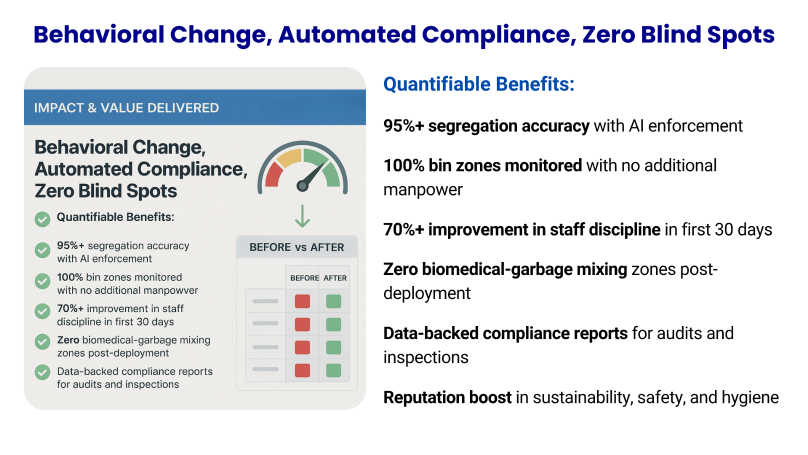
| Identified Challenge & Pain Point | Impact of an AI Hospital Waste Management System |
| Inaccurate and inconsistent manual segregation leading to contamination. | Achieves over 95% segregation accuracy by automating verification for every single disposal event. |
| Lack of accountability and difficulty in tracking sources of non-compliance. | Provides 100% auditable video/image proof for every violation, enabling targeted training and accountability. |
| High costs associated with resource-heavy manual audits and supervision. | Delivers 100% monitoring of all bin zones with no additional manpower, freeing up staff for patient care. |
| Delayed discovery of violations, increasing safety and environmental risks. | Flags violations in under two seconds, enabling immediate on-the-spot correction and preventing risks from escalating. |
| Difficulty providing proof of compliance for regulatory audits (e.g., under BMW Rules, 2016). | Generates automated, data-backed compliance reports, simplifying audits and demonstrating proactive governance. |
| Lack of data to understand and improve waste management processes. | The healthcare waste analytics dashboard reveals patterns, peak violation times, and departmental performance for data-driven optimization. |
| Risk of reputational damage from safety incidents or environmental violations. | Boosts hospital reputation as a leader in sustainability, safety, and technological innovation. |
This systematic approach to smart waste segregation for hospitals elevates the entire process from a manual chore to a strategic function. The deployment of a robust AI hospital waste management system is a clear indicator of an institution’s commitment to the highest standards of safety and care.
9. A Phased Approach to Implementation
Deploying a sophisticated AI hospital waste management system is a structured process designed for rapid, scalable implementation with minimal disruption.
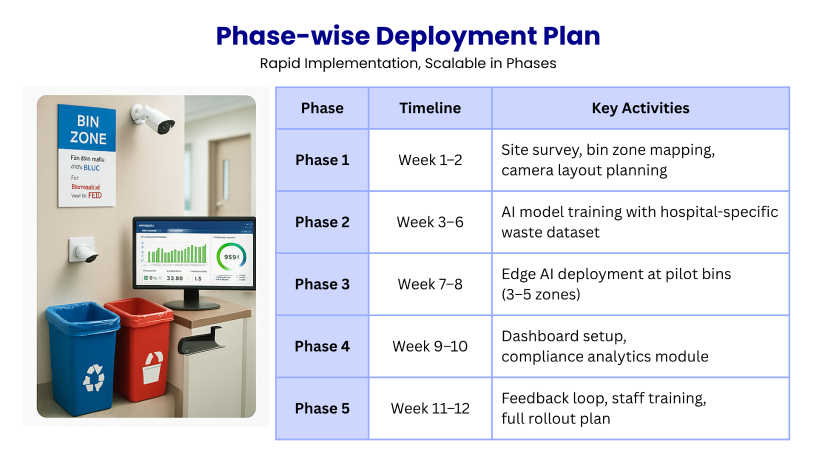
10. Important Considerations for Implementation
Deploying a sophisticated AI hospital waste management system requires careful planning and expert execution. Acknowledging these practical factors is the first step toward a successful implementation.
- Infrastructure & Environment: The system’s cameras and edge processors require reliable power and network connectivity. Planners must optimize camera placement, viewing angles, and ambient lighting conditions to ensure the AI models receive clear, high-quality visual data.
- Data & Model Customization: To achieve peak performance, the AI models must be trained and fine-tuned on a hospital’s specific waste items, packaging, and bin types. The system’s rules engine must also be configured to match the facility’s unique Standard Operating Procedures (SOPs).
- HIPAA Compliance and Data Security: Any technology vendor handling information in a healthcare setting must be fully compliant with the Health Insurance Portability and Accountability Act (HIPAA). This system is designed to analyze waste items, not identify patients. However, because it operates within a clinical environment, the vendor must be willing to sign a Business Associate Agreement (BAA), a legal contract that ensures all data is handled with the required safeguards to protect patient privacy.
- Integration with Existing Systems: For maximum impact, the AI hospital waste management system can integrate with other hospital platforms. Using its REST API (A standardized way for different software applications to communicate with each other), the system can connect with a Hospital Information System (HIS) or HR platform to link compliance data directly with employee records for training and performance management.
- Data Privacy & Ethics: If the optional feature for recognizing staff versus visitors is used, the facility must establish clear policies that comply with all relevant data privacy laws. The system’s primary focus should always remain on the action of disposal, not on the constant surveillance of individuals.
- Scalability & Maintenance: The system architecture must be designed to scale efficiently, growing from a pilot program in a single department to a full, hospital-wide deployment. Like any high-performance system, AI models require periodic maintenance and retraining to adapt to new types of waste items or changes in hospital protocols.
11. Frequently Asked Questions (FAQ)
How does the system handle staff and patient privacy under HIPAA?
The system is designed with privacy as a priority. Its primary function is to analyze the action of waste disposal and the object being discarded, not to identify or monitor individuals. As a technology vendor operating in a healthcare space, we are obligated to comply with HIPAA and will sign a Business Associate Agreement (BAA) to ensure all data is handled according to the strict physical, administrative, and technical safeguards required by the HIPAA Security Rule
What is the typical installation timeline for an AI hospital waste management system?
The timeline can vary depending on the size of the hospital and the scope of the deployment. A pilot program in a single department might take a few weeks, while a full, hospital-wide implementation typically ranges from 3 to 12 months. This includes phases for infrastructure assessment, camera installation, system configuration, AI model fine-tuning, and staff training.
Can the AI model be trained for our hospital’s specific waste items?
Yes. A key advantage of this technology is its adaptability. The YOLOv8 model can be fine-tuned on a custom dataset of images from your facility. This ensures the system accurately recognizes the specific types of packaging, medical supplies, and waste items unique to your hospital’s operations, leading to higher accuracy.
How does the system perform in low-light conditions, such as at night?
Object detection in low light is a known challenge for computer vision systems. However, YOLOv8 has shown significant robustness and improved performance in low-light environments compared to previous models.
For optimal performance, implementation includes ensuring adequate ambient lighting in disposal areas and using cameras with good low-light capabilities. The system can also be enhanced with specialized image processing techniques to improve visibility for the AI.
How is the data secured, especially on the cloud dashboard?
The system uses a hybrid edge-cloud architecture, which is inherently secure. The heavy video processing occurs on-site on the edge device, meaning raw video footage rarely leaves the hospital premises. Only small, lightweight metadata (like violation alerts and compliance counts) is sent to the secure cloud dashboard.
This cloud platform is protected by industry-standard security protocols, including data encryption and secure access controls, to ensure data integrity and confidentiality, in line with regulations like the DPDP Act.
12. Tailoring AI for Your Unique Needs with Softlabs Group
The powerful AI hospital waste management system described on this page represents a conceptual framework for what is possible. Realizing the full potential of such a solution—achieving over 95% segregation accuracy, enabling seamless integration, and driving transformative behavioral change—requires more than just off-the-shelf software.
It demands a deep, collaborative partnership with experts who understand how to apply AI to solve complex, real-world operational challenges. Every hospital has unique workflows, distinct regulatory pressures, and specific operational goals. A one-size-fits-all approach cannot deliver optimal results.
Softlabs Group specializes in this exact process: working closely with clients to design, build, and deploy truly bespoke AI solutions. We engineer systems that are not just technologically impressive, but are meticulously tailored to fit your specific environment and deliver the measurable outcomes your organization needs. An effective AI hospital waste management system is a custom-built asset.
Interested in a Proof-of-Concept for Your Facility?
